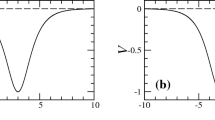Abstract
In this paper we study existence and asymptotic behavior of solitary-wave solutions for the generalized Shrira equation, a two-dimensional model appearing in shear flows. The method used to show the existence of such special solutions is based on the mountain pass theorem. One of the main difficulties consists in showing the compact embedding of the energy space in the Lebesgue spaces; this is dealt with interpolation theory. Regularity and decay properties of the solitary waves are also established.
Similar content being viewed by others
References
Abramyan, L.A., Stepanyants, YuA, Shrira, V.I.: Multidimensional solitons in shear flows of the boundary-layer type. Sov. Phys. Dokl. 37, 575–578 (1992)
Angulo, J., Bona, J.L., Linares, F., Scialom, M.: Scaling, stability and singularities for nonlinear, dispersive wave equations: the critical case. Nonlinearity 15, 759–786 (2002)
Ambrosetti, A., Rabinowitz, P.H.: Dual variational methods in critical point theory and applications. J. Funct. Anal. 14, 49–381 (1973)
Bona, J.L., Li, Y.A.: Decay and analyticity of solitary waves. J. Math. Pures Appl. 76, 377–430 (1997)
Bergh, J., Löfström, J.: Interpolation Spaces: An introduction. Springer, New York (1979)
Chandler-Wilde, S., Hewett, D.P., Moiola, A.: Interpolation of Hilbert and Sobolev spaces: quantitative estimates and counterexamples. Mathematika 61, 414–443 (2015)
Cunha, A., Pastor, A.: The IVP for the Benjamin–Ono–Zakharov–Kuznetsov equation in weighted Sobolev spaces. J. Math. Anal. Appl. 417, 660–693 (2014)
Cunha, A., Pastor, A.: The IVP for the Benjamin–Ono–Zakharov–Kuznetsov equation in low regularity Sobolev spaces. J. Differ. Equ. 261, 2041–2067 (2016)
de Bouard, A., Saut, J.-C.: Solitary waves of generalized Kadomtsev–Petviashvili equations. Ann. Inst. H. Poincaré Anal. Non Linéaire 14, 211–236 (1997)
de Bouard, A., Saut, J.-C.: Symmetries and decay of the generalized Kadomtsev–Petviasvili solitary waves. SIAM J. Math. Anal. 28, 1064–1085 (1997)
Duoandikoetxea, J.: Fourier Analysis, Translated and revised from the 1995 Spanish original by D. Cruz-Uribe, Graduate Studies in Mathematics, vol. 29. American Mathematical Society, Providence (2001)
Erdélyi, A., Magnus, W., Oberhettinger, F., Tricomi, F.G.: Tables of Integral Transforms, vol. I. McGraw-Hill Book Company, New York (1954)
Esfahani, A.: Decay properties of the traveling waves of the rotation-generalized Kadomtsev–Petviashvili equation. J. Phys. A Math. Theor. 43, 395201 (2010)
Esfahani, A., Pastor, A.: Ill-posedness results for the (generalized) Benjamin–Ono–Zakharov–Kuznetsov equation. Proc. Am. Math. Soc. 139, 943–956 (2011)
Esfahani, A., Pastor, A.: Instability of solitary wave solutions for the generalized BO–ZK equation. J. Differ. Equ. 247, 3181–3201 (2009)
Esfahani, A., Pastor, A.: On the unique continuation property for Kadomtsev–Petviashvili-I and Benjamin–Ono–Zakharov–Kuznetsov equations. Bull. Lond. Math. Soc. 43, 1130–1140 (2011)
Esfahani, A., Pastor, A., Bona, J.L.: Stability and decay properties of solitary-wave solutions to the generalized BO–ZK equation. Adv. Differ. Equ. 20, 801–834 (2015)
Gaidashev, D.G., Zhdanov, S.K.: On the transverse instability of the two-dimensional Benjamin–Ono solitons. Phys. Fluid 16, 1915–1921 (2004)
Hajaiej, H., Molinet, L., Ozawa, T., Wang, B.: Necessary and sufficient conditions for the fractional Gagliardo–Nirenberg inequalities and applications to Navier–Stokes and generalized boson equations. In: Harmonic Analysis and Nonlinear Partial Differential Equations, in: RIMS Kôkyûroku Bessatsu, vol. B26, Res. Inst. Math. Sci. (RIMS), Kyoto, 159–175 (2011)
Kato, K., Pipolo, P.N.: Analyticity of solitary wave solutions to generalized Kadomtsev–Petviashvili equations. Proc. R. Soc. Edinburgh 131A, 391–424 (2001)
McLean, W.: Strongly Elliptic Systems and Boundary Integral Equations. Cambridge University Press, Cambridge (2000)
Latorre, J.C., Minzoni, A.A., Smyth, N.F., Vargas, C.A.: Evolution of Benjamin–Ono solitons in the presence of weak Zakharov–Kuznetsov lateral dispersion. Chaos 16, 043103 (2006)
Lizorkin, P.I.: Multipliers of Fourier integrals. Proc. Steklov Inst. Math. 89, 269–290 (1967)
López, G.P., Soriano, F.H.: On the existence and analyticity of solitary waves solutions to a two-dimensional Benjamin–Ono equation. arXiv:1503.04291
Mariş, M.: On the existence, regularity and decay of solitary waves to a generalized Benjamin–Ono equation. Nonlinear Anal. 51, 1073–1085 (2002)
Pelinovsky, D.E., Shrira, V.I.: Collapse transformation for self-focusing solitary waves in boundary-layer type shear flows. Phys. Lett. A 206, 195–202 (1995)
Pelinovsky, D.E., Stepanyants, YuA: Self-focusing instability of nonlinear plane waves in shear flows. Sov. Phys. JETP 78, 883–891 (1994)
Ribaud, F., Vento, S.: Local and global well-posedness results for the Benjamin–Ono–Zakharov–Kuznetsov equation. Discrete Contin. Dyn. Syst. 37, 449–483 (2017)
Riesz, M.: Sur les fonctions conjuguées. Math. Z. 27, 218–244 (1927)
Shrira, V.I.: On surface waves in the upper quasi-uniform ocean layer. Dokl. Akad. Nauk SSSR 308, 732–736 (1989)
Triebel, H.: Interpolation Theory, Function Spaces, Differential Operators, North-Holland Mathematical Library, vol. 18. North-Holland Publishing Co., Amsterdam (1978)
Willem, M.: Minimax Theorems. Birkhäuser, Basel (1996)
Zaiter, I.: Solitary waves of the two-dimensional Benjamin equation. Adv. Differ. Equ. 14, 835–874 (2009)
Acknowledgements
The second author is partially supported by CNPq-Brazil and FAPESP-Brazil. The authors would like to thank F.H. Soriano for the helpful discussion concerning the construction of the extension operator and the referee for the careful reading and suggestions which improve the presentation of the paper.
Author information
Authors and Affiliations
Corresponding author
Additional information
Communicated by A. Malchiodi.
Appendix
Appendix
An important question concerning traveling-wave solutions one can ask is about their positivity. In this short appendix we verify that under suitable vanishing conditions at infinity, positive solitary waves do not exist. The numerical result also confirms this fact (see Figure 1).
The solitary wave of (1.6) and its projection curves for \(f(u)=u^2\)
Proposition 4.1
(Nonexistence of positive solitary waves) Suppose that f does not change the sign. Then there is no positive solitary-wave solution \(\varphi \) of (1.5) satisfying
Proof
It is straightforward to see that if \(\varphi \) is a nontrivial solution of (1.5) satisfying (4.1)–(4.3), then
On the other hand, \(\mathscr {H}\varphi =\mathscr {H}k*f(\varphi )\), where
By an argument similar to Lemma 3.8, there holds
The function \(\mathscr {H}k\) does not change the sign, since
The proof then follows because if \(\varphi \) is positive, \(\mathscr {H}\varphi =\mathscr {H}k*f(\varphi )\) has a definite sign, contradicting (4.4). \(\square \)




